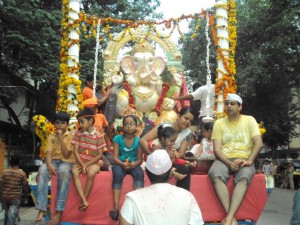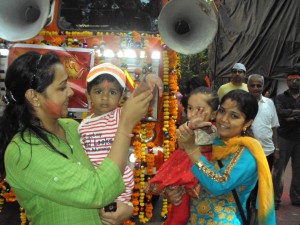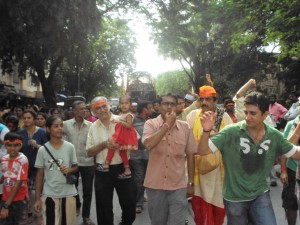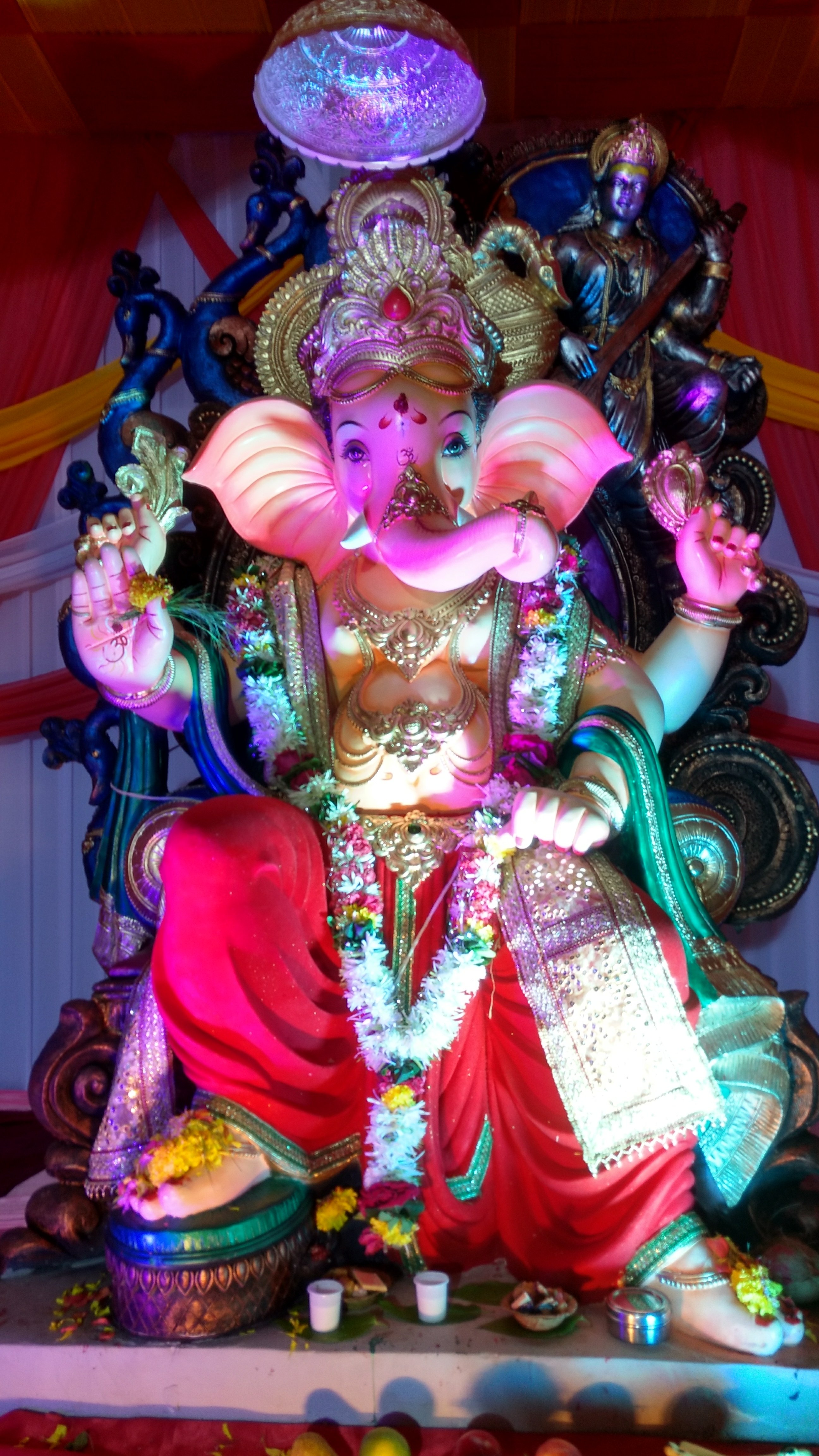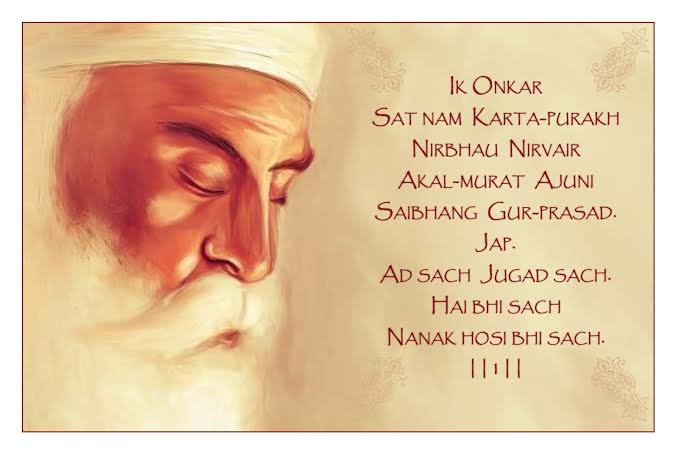
Category: God
A Beautiful Morning…

Krishna : Living in Harmony with the Contradictions of Life
The Lord has departed – We couldn’t receive His blessings
We invited Lord Ganesha to our world and He was with us for 10 days. We said our prayers, religiously every morning and evening, we changed our busy routines and schedules. We set aside the mechanical rush of the modern world, just to be heard by the Lord. Today, Lord Ganesha has departed, but we couldn’t receive his blessing. The Lord spoke to us, but we couldn’t hear Him. We stood near him, but he couldn’t see us.
He didn’t hear us because we surrounded Him with deafening sounds; he didn’t see us because of the glaring lights. And even as we bid farewell to the Lord today, and said our last prayers with emotions of joy and sadness, we gave Him a grand send-off with loud live bands and high decibels from loudspeakers that played cheap bollywood movie songs.
We live in the “Age of noise”. Physical noise, mental noise and the noise of desire. We are surrounded by the ringing of telephones, the clatter of keyboards, loud TV volumes, and high decibel sounds from vehicles on the road. Particles of noise cling to our souls – and they can only be cleansed in the waters of silence.
The living saint, Dada J.P. Vaswani writes, “I like to think of still, profound silence as personal, intimate appointment with God. And for those who wish to walk the way of spirituality, silence is the first and simplest step of the path. Silence is not just the absence of sound; silence has its own being; it is with you, within you. Silence is the language of the soul. Silence is two-fold, there is outer silence which is freedom from noise and there is inner silence which is freedom from clamour and desires. Silence cleanses. Silence heals, Silence strengthens, Silence reveals.”
It’s time that we realize that Lord speaks to us through silence. It is only in the depths of silence can we hear His Divine voice – not in the clamour and noise of this world. The most essential ingredient in prayer is not words, but the silence of the communion.”
Ganesha Wishes 2017
As Lord Ganesha comes home today, he brings along, good health and happiness (sukh), peace (shaanti) , prosperity (samriddhi) and wealth (sampada) for you, your family and your loved ones.
Let’s pray to the Lord for blessing us with righteousness (Sadbuddhi), right wisdom (Sadgyaan) and the courage to walk the righteous path (Sanmarg).
Thank You Lord Ganesha
Ganpati Bappa, Moriya
Happy Ganesh Chaturthi,
The Eternal Guru – Sri Guru Granth Sahib
The word “Guru” is derived from the root words “Gu”, which means darkness or ignorance, and “Ru”, which means light or knowledge The Guru is the one who guides us in our journey from darkness to light. The Guru is the experience of Truth (God).
I had always known about the ten Sikh Gurus, the first of whom was Guru Nanak, and the last Guru Gobind Singh. It was only recently, when I read the book “The Lives And Teachings of The Sikh Gurus”, by Harsh Dhillon, that I learned that there are not ten, but eleven Sikh Gurus, ten human and one eternal. The eleventh and eternal Guru of the Sikh religion is Sri Guru Granth Sahib.
I share this note on the eve of on Guru Nanak Jayanti, as an expression of the faith and belief in God that I have been blessed with after reading about the lives and teachings of the Sikh Gurus.
The story of the Sikh Gurus, is that of compassion, selfless service, valour and incomparable noble sacrifices. Each one of the ten human Gurus represents a divine attribute:
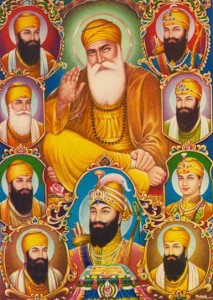
Guru Nanak – Humility
Guru Angad Dev- Obedience
Guru Amar Das — Equality
Guru Ram Das – Service
Guru Arjan Dev – Self-Sacrifice
Guru Hargobind – Justice
Guru Har Rai – Mercy
Guru Harkrishan – Purity
Guru Tegh Bahadur – Tranquillity
Guru Gobind Singh – Royal Courage
The history and the significance of the eleventh Guru, Sri Guru Granth Sahib is explained in the following text.
The first holy book of the Sikhs, now known as the Adi Granth, was complied on the behest of Guru Arjan Dev, the fifth Guru as an authentic collection of all the teachings and hymns composed by the first five Gurus. The hymns written in the Gurumukhi script, were composed for singing by the Sangat (religious gathering) and each Guru had indicated the Raag (musical tone) in which the composition was to be sung. The hymns in each Raag group were arranged in the chronological order of the Gurus. At the end of the book Guru Arjan Dev included the compositions of Hindu and Muslim saints such as Kabir, Ravidas, Namdev, Farid and others. The Granth was installed with great ceremony in the HarMandir Sahib, the holiest Sikh temple located in Amritsar. Later, Guru Gobind Singh, the tenth Guru, made the last addition to the Granth, including the 115 hymns written by Guru Tegh Bahadur.
Change of leadership always creates conflicts and disagreements. To avoid these wrangles and rivalries in the future, Guru Gobind Singh decided that after him there would be no Guru in flesh and blood. The tenth Guru announced, “Sabh Sikham kau hokum hai, Guru manyo Granth” (“We command all Sikhs to hold the Granth to be the Guru”). The holy book then became known as the Sri Guru Granth Sahib.

The Guru’s followers came to him to seek guidance in matters of religion and spirituality, and for advice regarding their day to day problems. All the teachings that the Sikhs needed would be got from the Granth which must be regarded as the permanent Guru; an unchangeable point on which they could focus their devotion and from which they could gain spiritual strength. For the day to day matters, the Sikhs could take help from the elected members of the community, known as the panth (panchayat). Guru Gobind Singh said, “Where there are five, there am I, where the five meet they are the holiest of the holy.”
For Sikhs, “Sri Guru Granth Sahib” is the living embodiment of the Guru, and is regarded with the utmost reverence and respect wherever it is found. The Sikhs bow to the Granth when they come into its presence. The sacred verses of Sri Guru Granth Sahib are called Gurbani. In all gurdwaras (place of religious worship of the Sikhs) and many Sikh homes, the Granth is read every day. No Sikh ceremony is regarded as complete unless it is performed in the presence of the Guru Granth Sahib. On a daily basis, Sikhs receive a hukam or divine order in the form of a hymn from the Guru Granth Sahib, either in a Gurdwara or at home. The hukam is the first hymn of the holy book from the left hand page when it is opened at random. Similarly, at the end of a service, after the ardas (Sikh prayer), the Adi Granth is opened at random and a portion is read. Many Sikhs do this daily, regarding the verses as words from God which they will find helpful during the day. This is called vak lao, taking advice.
On special occasions, the Granth Sahib is recited non-stop from cover to cover by a string of readers. This continuous reading of the Guru Granth Sahib is known as an akhand path. It is regarded as the highest and the noblest ceremony in the Sikh religion, and can be performed on any important occasion. It requires nearly 48 hours completing the continuous reading. A saptahak path is a daily reading of Guru Granth Sahib to be completed in seven days. It is sometimes undertaken in private homes as a mark of supplication on special occasions. A sehaj path is a reading of Guru Granth Sahib that can be completed at any length of period beyond seven days.
Guru Granth Sahib remains as a permanent unchangeable guide for all Sikhs as a living Guru or Teacher. It is a representation of the undaunted strength of the Sikh community. Guru Arjan Dev preferred a martyr’s death to saving his life through making alterations in the hymns as required by Emperor Jahangir. Anyone can open the pages of the Guru Granth Sahib and find strength and guidance through His Word: “The Guru is now always with me” (Guru Arjan, Raag Asa)
Written and Compiled by – Jayesh R. Tekchandaney, tekchandaney@gmail.com
Sources and Acknowledgements
“The Lives And Teachings of The Sikh Gurus”, by Harsh Dhillon
Introduction to Sikhism, http://fateh.sikhnet.com/s/SikhIntro
Sri Guru Granth Sahib, http://www.sikhismguide.org/granth.aspx
The Teachings of Guru Nanak
“There is but One God, The Supreme Truth; The Ultimate Reality, The Creator, Without fear, Without enemies, Timeless is His image, Without Birth, Self Created, By His grace revealed.”
Guru Nanak, the founder and the first Guru of the Sikh community taught people how they could live good, simple lives which would bring them closer to God. The following is the gist of Guru Nanak’s thoughts and teachings.
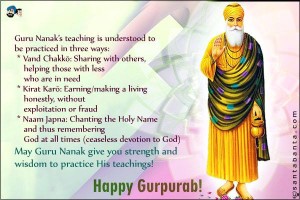
God – God is the essence in all of Nanak’s teachings. Guru Nanak believed that there is only one God, and that God is without form; God is neither born and so cannot die; God is Truth, so to behave in an untruthful manner would be to go against God.
Religion – Guru Nanak believed that true religion is a way of life. He was against the rites and rituals. He believed that when we worship God, it is not necessary to deify pictures or statues, as God is without form.
Guru – Nanak stressed on the importance of the Guru in a common man’s life. The Guru would help the disciple to understand God and to love him; the disciple must obey the Guru and follow his teachings and instructions with complete and unquestioning faith.
Prayers – It is only through our good deeds and actions that we can come close to God. True prayers are good actions and good deeds to others.
Leading Life – Guru Nanak taught that it is essential for every man to perform the duties of a householder – earning a living, getting married, bringing up one’s children, taking care of the parents, contributing to the society. He believed that there was no real good in giving up the world and living an isolated life. Instead man must live in equanimity and purity amongst the impurities of the world. He summed up this way of life by saying that people should work honestly, pray sincerely and be charitable.
Equality of Humans – Nanak did not believe in the caste systems. The crux of his teaching is “Equality of Humans”, without distinction of religion or creed. Guru Nanak preached that all his followers must sit together, without consideration of their wealth, social status or their caste, and became one united sangat by praying together and taking part in kirtan. The langar, a free kitchen in which food is served to all those who come to seek the blessings of the Guru, is the most visible representation of equality of humans.
Guru Nanak said, “We must be firm in our faith, our hearts must be clean, we must not have any greed or pride. We must not be troubled by life or death. We must accept the will of God. We must be unselfish and kind to all.”
Written and Compiled by – Jayesh R. Tekchandaney, tekchandaney@gmail.com
Sources and Acknowledgements
“The Lives And Teachings of The Sikh Gurus”, by Harsh Dhillon
God has been kind. If not ….
As I woke up this morning, the first thing I learned was about my friend Parvinder Singh, meeting with an accident yesterday, on his birthday, 18th July. We are all so happy for Parvinder that he was unhurt and is doing fine.
God has been kind. If not …
One would recall the true life story, I shared about my dear friend, Dr. Mitesh Shah. Mitesh missed out on our “Fab Four – Sachin, Amit, Mitesh , Jayesh” trip to Tirupati in 2009, to seek blessings from the Lord for our new borns. His father-in-law was diagnosed with a cardiac problem and Mitesh dropped out from the trip just an hour before our departure from Mumbai. A day later, exactly at the time when the three of us were at the Tirupati temple, Mitesh was admitted to a cardiac hospital – just in time to be taken care of.
God has been kind. If not …
Not many of my friends know, that at the age of 9 when I was in Class IV, I was diagnosed with a brain tuberculosis. The prayers, support and good wishes from family, friends, well wishers and doctors helped me recover in quick time. Dr. Ashok Hazari, our close relative and family doctor has been supporting the family right throughout the difficult times.
God has been kind. If not ….
I would like to conclude by sharing what could have possibly been life’s greatest regret. On 23rd May, 2015, Maahir and Shourya were playing in the building complex till well past 11 in the night. As always, either we would get them or someone would drop them home. It was not to happen that night. At around 11:30, I had a vision that Shourya has badly hurt himself . Seconds later, Maahir rushed into the house with Shourya’s bleeding and roughed up right hand. Shourya’s hand was trapped in the collapsible door of the moving lift causing a severe crushing injury – pulled off just in time.
It’s been a difficult two months for our six year old, with the many visits to Amit’s hospital – the first one within minutes of the incident, well past mid-night. Every time Amit opened the bandaged right hand for the painful medical processes, we would pray for things being fine.
Under the watchful eyes of my buddy, 
God has been kind. If not ….
PS – Our close family friends, two brothers, owned a popular fast food restaurant. Life presented them with many challenges, but with their ever positive and “never say die approach”, they did well for their families, inspite of critical heath issues. While the elder one (50) was on dialysis for the last 7 years, the younger one (47) too had to undergo the procedure on alternate days for the last 2 years. Both brothers had come to terms with life – going about their work, family and social responsibilities like all of us do. In January, the younger brother passed away within a month of a brief spout of ill-health. The elder brother had just begun to plan for the two families, only to be gone – 21 days later, after he developed some complications during the dialysis process.
Count your blessings.
God Bless
Life at Half Time
As another year of life goes by, the thought and realization that you are mid-way through life begins to dawn upon. Getting out of the thirties doesn’t hit you as much as the thought of entering into the forties. It seems to be the time, when life begins to question you –
What have you achieved?
What have you contributed?
Have you made the difference?
And above all – where do you go from here?
At “Half Time”, you need a “Time Out”. As we continue our journey in search for the answers – it’s time to reflect on the many gifts of life.
Thank God
One is thankful to God for his blessings of a loving and caring family, encouraging friends, inspiring teachers and supportive colleagues. “If I have seen far, it is because I have stood on the shoulders of giants.”
Set Goals
What we are today comes from our thoughts of yesterday, and our present thoughts build our life of tomorrow. Our life is the creation of our mind. Set Goals. “Whatever you vividly imagine, ardently desire, sincerely believe and enthusiastically act upon, must, inevitably come to pass.”
Never Give up
The journey of life has to be in pursuit of excellence. No matter how good you are, you can always get better – and that’s the exciting part. Never, never, never…never give up. “Koshish karne waloon ki kabhi haar nahin hoti.” (The one who tries, never fails).
Be Equanimous
Life is a journey – of ups and downs, of joys and sorrows. Life’s greatest challenge is learning to be equanimous in both pleasure and pain. The true measure of progress is our state of consciousness and the change this brings about in our thoughts, behavior, attitude, actions and responses. “Adversity introduces a man to himself”.
Life Comes Full Circle
Over the many years, one has realized that life is a great equalizer; what you give is what you get. Life is too long. In the end, life comes full circle. Circumstances and people will come back. Remember, “There is no witness so terrible or no accuser as powerful as conscience.”
Time is Precious
Money is a by-product of hard, honest work. Health is wealth. Our greatest gift and most precious asset is “Time”. And, while we may want to believe that we are at half time, none of us knows when the Referee decides to blow the whistle.
Have Faith
We often regret when things don’t happen as we plan them, only to realize later that it all happens for a reason. There is a popular Malayalam quote, “Njan pathi, daivam pathi” – it means, I need to do my half, the rest shall be done by the Lord.
Where Do You Go From Here?
Our life is on the line every single day. Each day, we script our story – through thoughts, words and actions. Every day we build our legacy, and everyday our eulogies are being written.
Going forward, one prays for good health, peace, and prosperity for self, friends, family; knowledge and values for children; and seeks blessing to be a good human being, a leader with the ability to touch, move, inspire and make a difference to the lives of those around. “Life is not about keeping or settling scores. It’s about understanding people the way they are. Above all, it is about choosing to use our life to touch someone else’s in a way that could not have been possible otherwise.”
“Success is in the big things. Happiness is in the small things. Meditation is in nothing. God is in everything.”
Life has been a Blessing
Life has been a blessing
A blessing of a loving family,
A blessing of inspiring teachers and mentors,
A blessing of friends who have always been encouraging and supportive,
A blessing of colleagues and team members.
A blessing of good health,
A blessing of peace,
A blessing of prosperity,
A blessing of education and knowledge,
A blessing of spirituality,
A blessing of equanimity,
A blessing of positivity.
A blessing of mother nature,
A blessing of air, water and food,
A blessing of India,
A blessing of home,
A blessing of work,
A blessing of books.
A blessing of the many goals that manifested for the good.
A blessing of hard work, persistence and perseverance.
Life has been a blessing of being loved and cared for,
God has been kind,
Life is Beautiful.
Life’s purpose has been to touch, move, inspire and make a positive difference,
God Bless Life.


